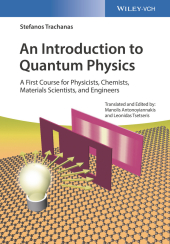 Neuerscheinungen 2017Stand: 2020-02-01 |
Schnellsuche
ISBN/Stichwort/Autor
|
Herderstraße 10
10625 Berlin
Tel.: 030 315 714 16
Fax 030 315 714 14
info@buchspektrum.de |

Manolis Antonoyiannakis, Stefanos Trachanas, Leonidas Tsetseris
(Beteiligte)
An Introduction to Quantum Physics
A first course for physicists, chemists, materials scientists, and engineers
1. Auflage. 2017. XXVIII, 536 S. 197 SW-Abb. 244 mm
Verlag/Jahr: WILEY-VCH 2017
ISBN: 3-527-41247-6 (3527412476)
Neue ISBN: 978-3-527-41247-1 (9783527412471)
Preis und Lieferzeit: Bitte klicken
Ein umfassendes Lehrbuch der Quantenphysik und Chemie sowie der Struktur von Materie. Eignet sich für Anfänger und Fortgeschrittene und bietet zusätzlich Online-Übungen zur Überprüfung des Lehrstoffes, Laborübungen mit Mathematica sowie ein komplettes Lösungshandbuch.
Foreword
PART I: Fundamental Principles
THE PRINCIPLE OF WAVE-PARTICLE DUALITY: AN OVERVIEW
The Principle of Wave-Particle Duality of Light
The Principle of Wave-Particle Duality of Matter
Dimensional Analysis and Quantum Physics
THE SCHRÖDINGER EQUATION AND ITS STATISTICAL INTERPRETATION
INTRODUCTION: The wave-particle duality as the fundamental law of modern quantum mechanics
The Schrödinger Equation
Statistical Interpretation of Quantum Mechanics
Further Development of the Statistical Interpretation: The Mean-Value Formula
Time Evolution of Wavefunctions: Superposition States and Further Development of the Statistical Interpretation
Self-Consistency of the Statistical Interpretation and the Mathematical Structure of Quantummechanics
Summary: Quantum Mechanics in a Nutshell
THE UNCERTAINTY PRINCIPLE
The Position-Momentum Uncertainty Principle
The Time-Energy Uncertainty Principle
The Uncertainty Principle in the Classical Limit
General Investigation of the Uncertainty PrinciplePART II. Simple Quantum Systems
SQUARE POTENTIALS I
Particle in a One-Dimensional Box: The Infinite Potential Well
The Square Potential Well
SQUARE POTENTIALS II
The Square Potential Step: Reflection and Transmission
Rectangular Potential Barrier: Tunneling Effect
THE HARMONIC OSCILLATOR
Solution of the Schrödinger Eequation
Discussion of the Results
A Plausible Question: Can we use the Polynomial Method to Solve Potentials other than the Harmonic Oscillator?
THE POLYNOMIAL METHOD
Sufficient Conditions for the Existence of Polynomial Solutions: Bidimensional Equations
The Polynomial Mehtod in Action: Exact Solution of the Krätzer and Morse Potentials
Mathematical Afterword
THE HYDROGEN ATOM I
Solving the Schrödinger Equation for the Spherically Symmetric Eigenfunctions
Discussion of the Results
What is the Electron Doing in the Hydrogen Atom after all? A First Discussion on the Basic Questions of Quantum Mechanics
THE HYDROGEN ATOM II
The Schrödinger Equation in an Arbitrary Central Potential: The Method of Separation of Variables
The Hydrogen Atom
ATOMS IN A MAGNETIC FIELD - THE EMERGENCE OF SPIN
Atomic Electrons as Microscopiy Magnets: Magnetic Moment and Angular Momentum
The Zeeman Effect and the Evidence for the Existence of Spin
The Stern-Gerlach Experiment: Unequivocal Experimental Confirmation of the Existence of Spin
What is Spin?
Time Evolution of Spin in a Magnetic Field
Total Angular Momentum of Atoms: Addition of Angular Momenta
IDENTICAL PARTICLES AND THE PAULI PRINCIPLE
The Principle of Indistinguishability of Identical Particles in Quantum Mechanics
Indistinguishability of Identical Particles and the Pauli Principle
The Role of Spin: Complete Formulation of the Pauli Principle
The Pauli Exclusion Principle
Which Particles are Fermions and Which are Bosoms
Exchange Degeneracy: The Problem and its Solution
PART III. Quantum Mechanics in Action: Structure of Matter
ATOMS
Arrangement of Energy Levels in Many-Electron Atoms: The Screening EffectQuantum Mechanical Explanation of the Periodic Table: The "Small Periodic Table"
Approximate Calculations in Atoms: Perturbation Theory and the Variational Method
MOLECULES I
The Double-Well Model of Chemical Bonding
Examples of Simple Molecules
Molecular Spectra
MOLECULES II
Hybridization: The First Basic Deviation from the Elementary Theory of the Chemical Bond
Delocalization: The Second Basic Deviation from the Elementary Theory of the Chemical Bond
SOLID STATE
Periodicity and Band Structure
Band Structure and the "Mystery of Conductivity." Conductors, Semiconductors, Insulators
Crystal Momentum, Effective Mass, and Electron Mobility
Fermi Energy and Density of States
MATTER AND LIGHT
The Four Fundamental Processes: Resonance, Scattering, Ionization, and Spontaneous EmissionQuantitative Description of the Fundamental Processes: Transition Rate, Effective Cross Section, Mean Free Path
Matter and Light in Resonance. I: T


